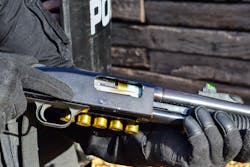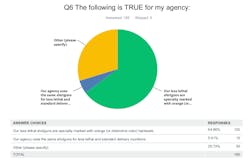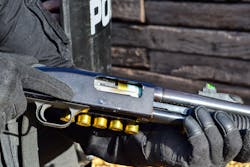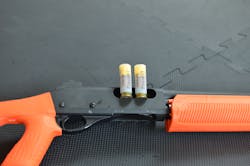Why You Should Add The 12 Gauge Shotgun To Your Less Lethal Arsenal
The purpose of nonlethal projectiles is to provide standoff capability, whether it is crowd control, disarming EDPs or other tactical situations where the potential for delivering less lethal over lethal exists.
I started working on this article when several companies involved in less lethal products contacted me with questions about 12 gauge less lethal deployment and products. Law enforcement agencies had been contacting these companies and asking them what products to use for less lethal—that is, people purchasing munitions were asking which shotguns to use and which stocks to buy. Meanwhile, agencies that were purchasing retrofit orange or red stocks were asking which munitions to purchase. There seemed to be a lack of resources for these agencies when it came to 12 gauge less lethal options.
Why were these agencies interested in 12 gauge less lethal options in the first place? 12 gauge less lethal is just about the best bargain in law enforcement today, in my opinion. The munitions are inexpensive, practice and training is inexpensive and these systems simply work.
LEOs participate in a less lethal survey
I polled many agencies to see what they were using for less lethal and to get a look at their practices. Although most of the respondents stated that their agency uses TASERs, more than 1/5 of all the agencies used shotgun-launched less lethal munitions. The majority of the shotgun users employed dedicated less lethal shotguns. Very few did not have dedicated shotguns.
The only alarming result from our survey was that 1.61 percent of officers reported that specialized training or deploying less lethal munitions was not required in their agency.
Several agencies reported that they do not use less lethal tools at all. In an open-ended question, allowing officers to respond with a sentence or two, they explained that they didn’t have a policy for tools for delivering anything less lethal.
One respondent stated that they use a shotgun for less lethal applications and controlling wildlife. I can only infer from the response that a single shotgun is used for lethal and less lethal purposes, specifically for wildlife and law enforcement response.
Several reported that their agencies use other less lethal delivery systems not listed in the survey, including FN 303 launchers and PepperBall launchers. Respondents who reported using 37mm and 40mm (which were quite a few) stated they use sponge projectiles.
There are many types of projectiles, including .50 caliber rubber balls, rubber buckshot, elastomer “star” projectiles and drag stabilized socks. Our survey suggests that the sock type is the most popular.
By a wide margin, the most common less lethal tool is the TASER.
Use training to develop policy
Regardless of what less lethal options are used or not used at an agency, training with the equipment and having a strong policy in place is of key importance. One of the most common questions asked is where to get the training. First, every state has a version of a POST (Peace Officer Standards and Training). I reviewed the catalogs of several states and found that most of them had some sort of training on less lethal delivery. Most of the development courses in the catalogs were “train the trainer”. In the California POST catalog, the host agency even specifies which munitions systems are trained at the session. It is important to be educated in equipment and legislative updates.The Safariland Training Academy offers training in several less lethal delivery platforms—obviously, officers will have an opportunity to see Safariland products. Some survey respondents reported that this training was useful in developing policy.
Mace Tactical Solutions has a 4-Day Less Lethal Instructor Course and a 2-Day Recert. They also cover a portion of liability and documentation, which is useful for helping an agency formulate a policy. If we look at some of the parts of the course included in Mace Tactical Solutions Training, it covers agents, munitions and policy development.
When looking for a training program, it helps to know that the training has a more global field of view.
It is critical that officers receive formal, documented training and routinely receive training updates, both legislative and hands-on. The training needs to be organic and nonorganic (or produced and not produced by the agency). This will ensure that the agency can demonstrate a cognizance of objectively reasonable use of force, as in Tennessee v. Garner and Graham v. Connor. That is, if officers are trained by experienced trainers, they are exposed to concepts that produce a level of reasonable training and experience. Additionally, training adds the understanding of rapidly changing environments that require split second decisions.
The more training an officer gets, the more it is reasonable to deduce that their actions reflect the current law and policies in effect at the time of the application of force.
Separate your shotguns
I want to make this clear: It is unreasonable to use the same shotgun for delivering lethal force as it is less lethal force. Most agencies recognize this and retrofit their shotguns with orange or bright red stocks. This retrofit should probably include a locked case for the shotgun and even a policy that states that the less lethal user cannot have lethal rounds on their person or in their vehicle. Some agencies who have made a complete transition have policies stating that lethal shotgun rounds are not allowed in any of the properties of the agency.
The bright orange forend is the best part. It has heavy bolded lines and a wide bottom, adding to the positive grip. I found it easy to support the shotgun with just the buttstock and pistol grip with this set up. This is definitely a consideration when the less lethal officer is holding a ballistic shield while steering a shotgun. The orange color is in the material, not on the surface. No amount of scratching or rough handling will cause a color fade. The best part is a 2-inch Picatinny rail concealed under the nose cap of the forend. Adaptive Tactical makes a 300 lumen light that clips into this rail. For users who like this setup, it comes in black also.
Shotgun-launched less lethal products are still relevant and efficient. The 12 gauge less lethal tool may be the most cost-effective thing out there for law enforcement agencies and will continue to be useful for decades to come. Agencies must be certain, however, to train with their equipment and have a solid policy in place.
Policy & Procedure Recommendations
- Train to fire multiple rounds: When we train to deliver less lethal tools, we have to train to fire multiple rounds. Sometimes the first one works, sometimes it doesn’t. Like any other tool, officers must be cognizant of “fire and assess.” In testimony, this response has to be backed with training and experience.
- Understand the deployment might not work: Like any other force delivery, the user has to operate with the attitude “This is not going to work.” I tell my students the same thing. This doesn’t mean we shouldn’t have any confidence in the tools that we are using, it simply means that there must be a backup plan in place and already pre-deployed. In the case of shotgun-launched less lethal, the delivering officer must be flanked by lethal force for the prevention of officers and the public. It is also important for an arrest team, or team member designated to do the arrest, to be part of the flank.
- Re-use bean bags only for training: Some bean bag products are reusable. This is great for training, but could increase liability when used in a real tactical situation. That is, “Officer, is it true that you used a recycled product to subdue my client? Is there some sort of message you are trying to convey?”
- Pre-stage medical: Your less lethal deployment policy needs to include pre-deployment of medical personnel. In my experience, the best way to do this is to pre-stage an ambulance nearby, if possible. If the tactical situation dictates, the SWAT EMT may be the first person to do patient treatment. As long as it is in the policy and the policy is followed, this is a good practice. The idea is to demonstrate in the policy that no delay of medical treatment exists.
- Document each deployment: Each less lethal deployment must be documented, whether a projectile is fired or not. Obviously, it is best to have body cameras running throughout the whole incident. The injury should be photographed at the scene as contemporaneous as possible to the deployment, followed by other investigatory photographs. Include in the photographs the deployed projectile and cartridge from which it was fired. Care must be taken to respect the privacy and modesty of the suspect. Even if there doesn’t appear to be contact or injury, a photograph should be taken.
- Use a standard verbal warning before deployment: Even the suspect needs to hear the verbal warning, which can be, “Bean bag, bean bag, bean bag” or similar. Bean bag rounds are drag stabilized—a non-aerodynamic projectile is fired that has a tail that is even less aerodynamic. The heavy nose and non-aerodynamic tail keep the impact area always facing forward. They are generally filled with lead shot, packed loosely in the sock.
About the Author

Officer Lindsey Bertomen (ret.), Contributing Editor
Lindsey Bertomen is a retired police officer and retired military small arms trainer. He teaches criminal justice at Hartnell College in Salinas, California, where serves as a POST administrator and firearms instructor. He also teaches civilian firearms classes, enjoys fly fishing, martial arts, and mountain biking. His articles have appeared in print and online for over two decades.



